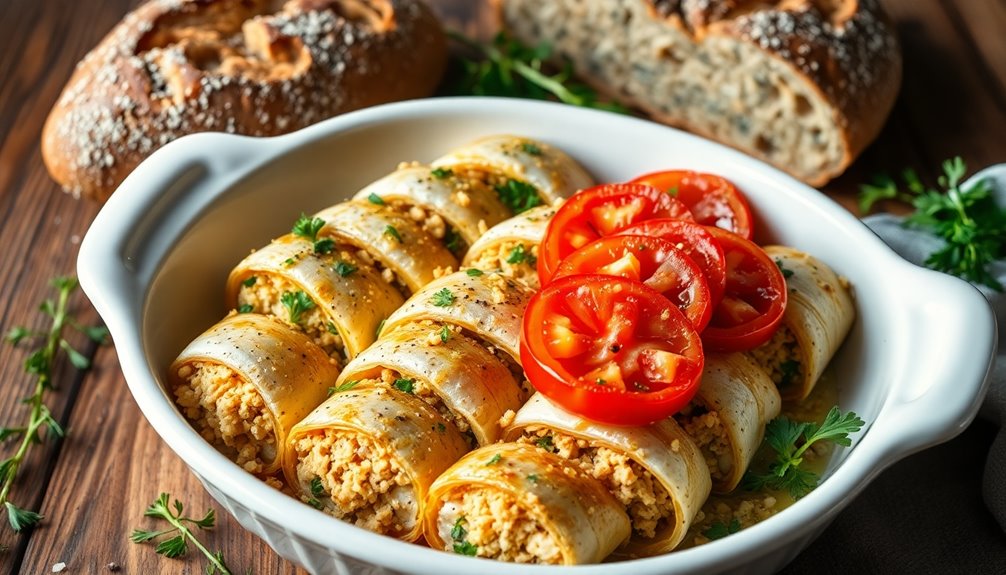Baked herring rolls under a tomato cap are a delicious way to enjoy a piece of Britain's culinary heritage. You start by rolling fresh herring with a tasty mixture of breadcrumbs, herbs, and onions. Then, place them in a baking dish topped with sliced tomatoes and drizzle with olive oil. Bake until they're tender and flaky. This dish not only highlights the fish's natural flavors but also harks back to the coastal communities that once thrived on herring. Learn about the history behind this recipe and more ways to enjoy herring.
History

When you think of herring in British cuisine, it's hard to ignore its rich history shaped by both economic shifts and cultural pride.
The British herring industry surged in the early 1900s, with over 12,000 active fishermen bringing this affordable protein to tables across the nation. However, overfishing led to a sharp decline, culminating in a total ban in the late 1970s, which drastically impacted the seafood market.
The Herring Industry Board, established in 1935, aimed to revitalize interest in herring during tough economic times, publishing recipe booklets to encourage consumption. Notable culinary efforts by authors like Mrs. Stanley Wrench and Mrs. Arthur Webb helped highlight herring's significance, particularly for coastal communities, where fisher girls played a vital role in processing the catch.
Recipe
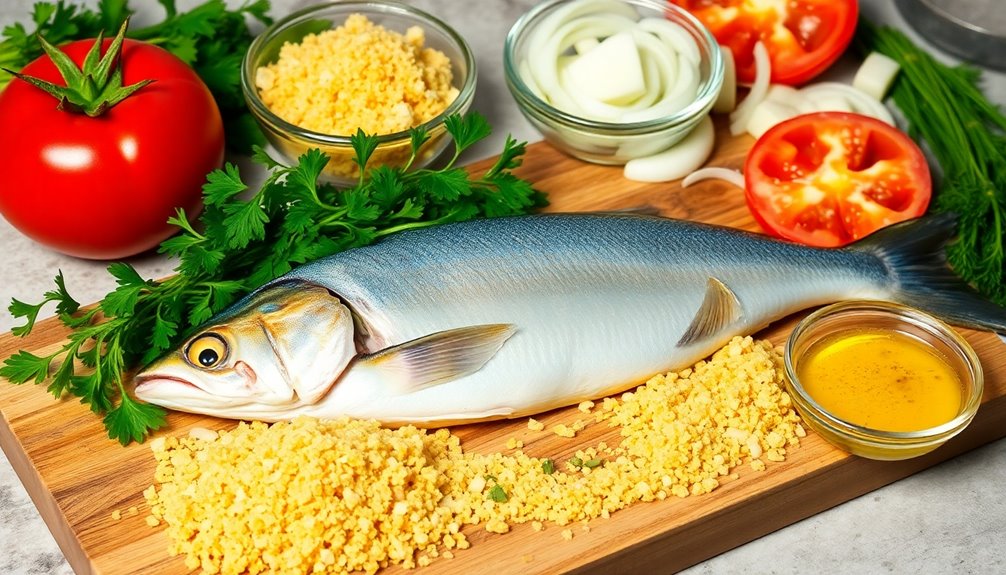
To achieve the best results, use fresh, high-quality herrings and season them generously. The baking process allows the flavors to meld together while ensuring the fish is tender and flaky.
Pair these herring rolls with crusty wholemeal bread and a sprinkle of fresh herbs for a delicious and satisfying meal that highlights the natural flavors of the ocean.
Ingredients:
- Fresh herring (scaled and gutted)
- Breadcrumbs
- Fresh herbs (such as parsley or dill)
- Finely chopped onions
- Sliced tomatoes
- Olive oil
- Salt
- Pepper
Cooking Instructions: Begin by preheating your oven to 180°C (Gas 4). Take the cleaned herring and roll them up with a mixture of breadcrumbs, herbs, and chopped onions for the filling.
Arrange the rolled herring in a baking dish, topping them with sliced tomatoes. Drizzle with olive oil and season with salt and pepper. Cover the dish with foil to help retain moisture, and bake for 20-25 minutes, or until the fish is cooked through and tender.
Extra Tips: For added flavor, consider marinating the herring in lemon juice and herbs for about 30 minutes before rolling them up. This can enhance the taste significantly.
Additionally, feel free to experiment with different herbs or even add a touch of garlic to the filling for an extra kick. Serve the baked herring rolls immediately for the best flavor and enjoy the fresh, vibrant tastes of the dish.
Cooking Steps

To start making your baked herring rolls, you'll want to preheat your oven to 375°F.
Carefully prepare the herring rolls, adding a delicious tomato cap topping before placing them in the oven.
Bake for about 25 minutes, and don't forget to sprinkle some herbs for an extra burst of flavor!
Step 1. Preheat Oven to 375°F

Preheating your oven to 375°F (190°C) is essential for baking the perfect herring rolls under a tomato cap. This temperature allows the whole fresh herrings to cook evenly, ensuring they remain moist and flavorful.
Before you begin, prepare your baking dish by lightly greasing it; this helps distribute heat evenly throughout the rolls. As you place the herring rolls in the dish, pack them tightly to prevent drying out while baking.
You'll want to bake in a moderate oven for approximately 25-30 minutes. Keep an eye on them until the tomatoes are tender and the herring rolls turn golden brown.
This careful preparation sets the stage for a delicious and satisfying dish.
Step 2. Prepare Herring Rolls Carefully
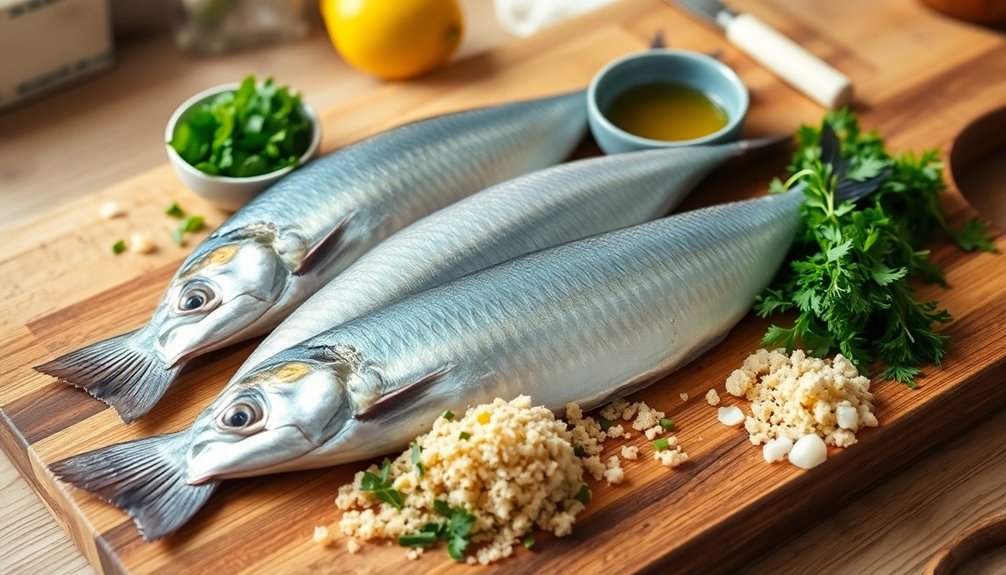
With the oven set to 375°F, you're ready to prepare the herring rolls that will be baked to perfection.
Begin by scaling and gutting fresh herring, ensuring it's clean. Carefully remove the bones from the fillets, keeping them intact for rolling.
Next, prepare a stuffing mixture using breadcrumbs, herbs, and a small amount of cream cheese mixed with finely shredded ingredients. Spread this mixture along the center of each herring piece before rolling them up tightly.
Secure the rolls with toothpicks or kitchen twine to maintain their shape. Once rolled, place them in a baking dish and cover with a layer of herring and sliced tomatoes along with a drizzle of tomato puree, allowing the flavors to meld during baking.
Step 3. Add Tomato Cap Topping
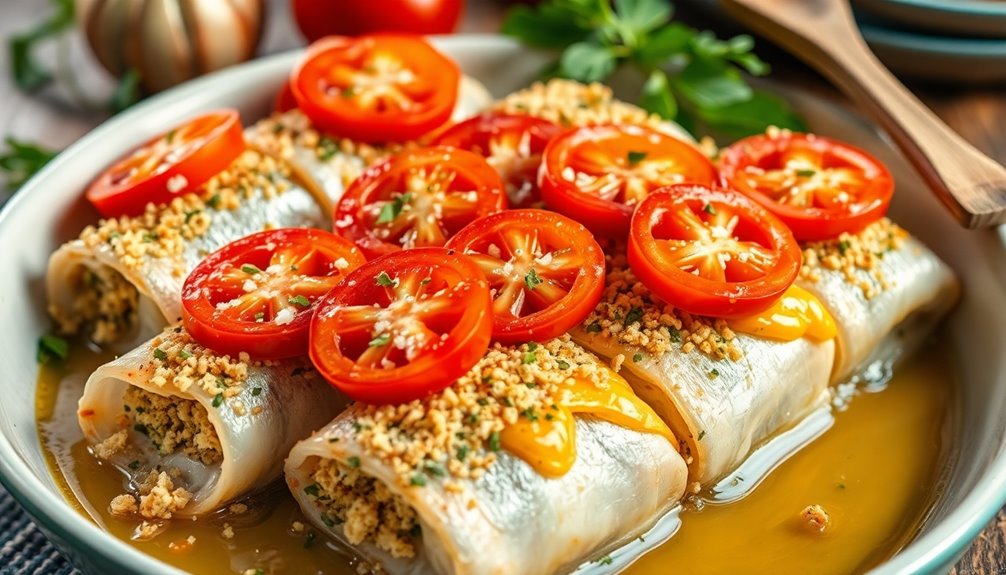
As you prepare to add the tomato cap topping, finely chop fresh tomatoes and mix them with herbs like parsley or dill for an extra burst of flavor.
Make sure your herring rolls are tightly secured, as the tomato cap will help retain moisture during baking and enhance the dish's overall taste.
Generously place the tomato mixture over the herring rolls, allowing the juices to infuse the fish as it bakes.
If you want a richer flavor, consider sprinkling grated cheese on top of the tomato cap before baking. This will melt into a delicious crust.
Once baked, serve the herring rolls immediately, letting the tomato cap cool slightly for optimal presentation and flavor.
Enjoy!
Step 4. Bake for 25 Minutes

Once you've added the flavorful tomato cap, it's time to bake those herring rolls.
Preheat your oven to 180°C (Gas 4) to ensure even cooking. Place the rolled herring in a baking dish, covering them with a layer of sliced tomatoes.
Don't forget to season with salt and pepper for an extra flavor boost. Now, slide the dish into the preheated oven and bake for 25 minutes.
This allows the fish to cook thoroughly while the tomatoes soften, creating a delicious cap. If you want, check the herring rolls halfway through baking.
You can sprinkle on some herbs or drizzle a bit of olive oil for added moisture. Serve the baked herring hot, garnished with fresh herbs!
Step 5. Add Herbs for Flavor
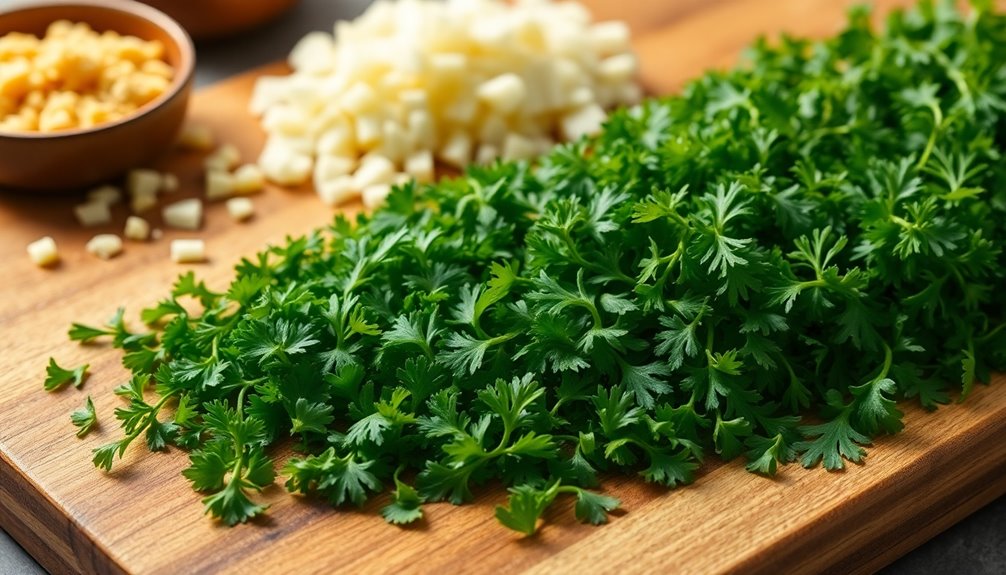
To elevate the flavor of your baked herring rolls, consider incorporating fresh herbs like dill, parsley, or thyme.
Start by marinating the herring in a mixture of lemon juice and finely chopped herbs. This step infuses the fish with aromatic flavors that enhance the final dish.
For the stuffing, mix in fresh dill or your choice of herbs to provide a fragrant experience.
After rolling the herring, sprinkle some oregano or basil on top of the tomato cap. This adds a delightful contrast to the sweetness of the tomatoes, deepening the overall flavor.
Not only do these herbs boost flavor, but they also enrich the dish with vitamins and antioxidants, making your baked herring rolls even more enjoyable.
Final Thoughts
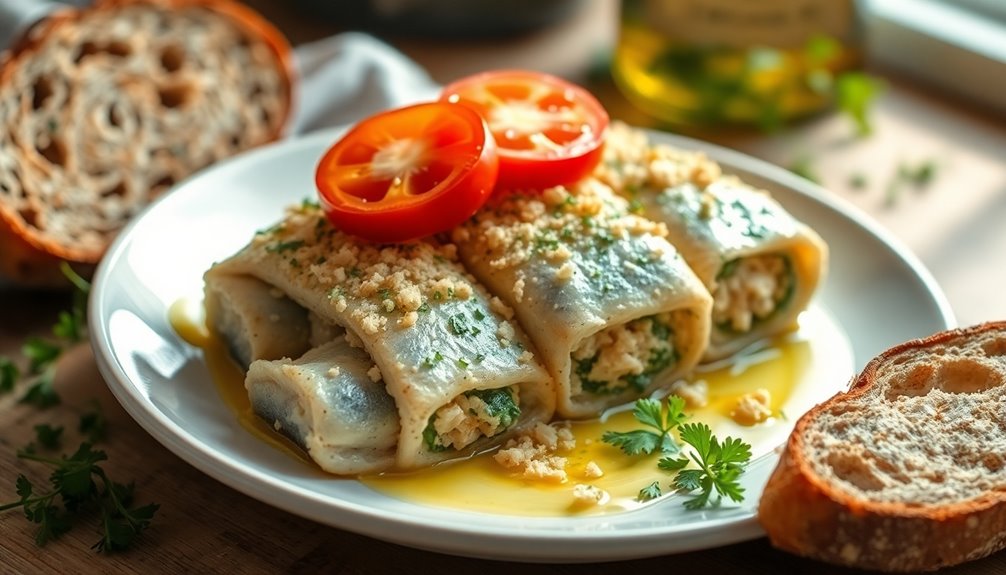
While you may find many modern dishes vying for attention, baked herring rolls stand out for their rich history and nutritional benefits. This dish not only showcases the affordability and nutritional value of herring but also highlights traditional cooking methods, which are essential for preserving culinary heritage.
Baking herring under a tomato cap at a moderate oven temperature allows the flavors to meld beautifully, creating a delightful contrast. By incorporating seasonal vegetables into the filling, you embrace the practice of using local ingredients, enhancing both taste and sustainability.
Serving these rolls with wholemeal or granary bread pays homage to the communal meal tradition in coastal communities. Ultimately, baked herring rolls aren't just a meal; they're a journey through history, flavor, and nourishment. Additionally, the use of natural ingredients in this recipe reflects a growing trend towards sustainable cooking practices.
Frequently Asked Questions
How Long Does Herring Take to Cook in the Oven?
When you're cooking herring in the oven, it typically takes about 20 to 30 minutes at 180°C (Gas 4).
Keep an eye on the size and thickness of the fillets, as that can affect the cooking time.
You'll know it's done when the flesh turns opaque and flakes easily with a fork.
Always check that the internal temperature reaches at least 63°C (145°F) to ensure it's fully cooked and safe to eat.
How to Eat Herring in the Oven?
To eat herring from the oven, you'll want to savor its rich flavor while balancing it with fresh accompaniments.
Pair the warm fish with a squeeze of lemon, contrasting its savory taste with a zesty kick. Enjoy it alongside crusty bread or a crisp salad, creating a delightful mix of textures.
As you indulge, let the tender herring melt in your mouth, providing a satisfying experience that's both comforting and vibrant.
What Is the Best Way to Eat Canned Herring?
Canned herring's a versatile treat that you can enjoy in various ways.
If you're looking for a quick snack, eat it straight from the can for a nutritious boost. For something more flavorful, mix it with mustard or yogurt to create a tasty spread for crackers.
You could also toss it into salads or warm dishes like pasta for a hearty meal. Don't forget to pair it with Mediterranean ingredients for a delightful twist!
What Is the Best Way to Prepare Herring?
To prepare herring, you'll want to start with fresh fish.
Clean it thoroughly under cold water, removing scales and guts. Score the flanks for better seasoning penetration, then spread butter inside for moisture.
Season with lemon juice, sea salt, and black pepper.
Skewer the fish, arrange tomatoes and lemon wedges around it in a baking dish, and bake at 180C for 15 minutes, uncovering for an additional 5 to enhance flavor.
Enjoy!
